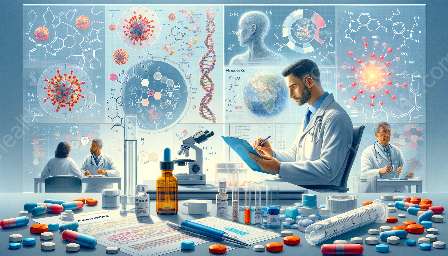When it comes to the intricate world of pharmacokinetics and pharmacy, one crucial aspect that cannot be overlooked is the concept of drug interactions. Drug interactions occur when the effects of one drug are altered by the presence of another drug, food, or other substance.
What Are Drug Interactions?
Drug interactions can either increase or decrease the therapeutic effects of a drug, or lead to adverse effects and toxicity. These interactions can occur at various stages, including absorption, distribution, metabolism, and excretion, which are the fundamental components of pharmacokinetics.
Understanding the mechanisms behind drug interactions is essential for healthcare professionals to ensure the safe and effective use of medications.
Pharmacokinetics and Drug Interactions
Pharmacokinetics, the study of how drugs move through the body, provides a comprehensive framework for understanding drug interactions. The various processes involved in pharmacokinetics, such as absorption, distribution, metabolism, and excretion, can be affected by interactions with other drugs.
1. Absorption: Drug interactions can impact the absorption of a drug in the body. For example, the presence of certain foods or drugs can alter the absorption rate of a medication, leading to inconsistent therapeutic effects.
2. Distribution: The distribution of a drug within the body can also be influenced by interactions with other drugs. This can lead to changes in drug concentration at the site of action, affecting the overall pharmacological response.
3. Metabolism: Drug interactions often occur at the metabolic level, where one drug may inhibit or induce the enzymes responsible for metabolizing another drug. This can lead to changes in plasma drug concentrations and potentially alter therapeutic outcomes.
4. Excretion: The elimination of drugs from the body can be affected by interactions that impact renal or hepatic function, leading to imbalances in drug levels and potential toxicity.
Types of Drug Interactions
Drug interactions can be classified into several types based on their mechanisms:
1. Pharmacodynamic interactions: These interactions occur when one drug alters the effects of another drug at the site of action, leading to enhanced or reduced pharmacological effects.
2. Pharmacokinetic interactions: Pharmacokinetic interactions involve changes in the absorption, distribution, metabolism, or excretion of a drug, resulting from the presence of another drug or substance.
3. Drug-food interactions: Certain foods or beverages can interact with medications, affecting their absorption, metabolism, or excretion.
4. Drug-herb interactions: Herbal products and natural supplements can also interact with conventional medications, leading to potential adverse effects or altered therapeutic outcomes.
Management of Drug Interactions in Pharmacy
Pharmacists play a critical role in identifying, evaluating, and managing drug interactions to ensure patient safety and optimize therapeutic outcomes. The following strategies are essential in the management of drug interactions:
1. Comprehensive medication review: Pharmacists conduct thorough reviews of patients' medication regimens to identify potential interactions and provide appropriate recommendations.
2. Patient counseling: Pharmacists educate patients about the importance of adherence to prescribed medications and provide guidance on avoiding potential interactions, including dietary and herbal considerations.
3. Utilization of drug interaction databases: Pharmacists utilize advanced tools and databases to assess potential drug interactions and make informed decisions regarding medication therapy.
4. Collaboration with healthcare providers: Pharmacists collaborate with prescribers and other healthcare professionals to address and resolve drug interactions, promoting interprofessional communication and patient-centered care.
Conclusion
Understanding drug interactions and their impact on pharmacokinetics is crucial for healthcare professionals in providing safe and effective medication therapy. By embracing a comprehensive approach to managing drug interactions, pharmacists and other healthcare providers can ensure optimal patient care and treatment outcomes in the complex landscape of modern pharmacy.


